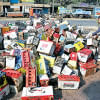From lead poisoning to cardiac deaths

Lead pollution is a pervasive global problem impacting millions of people worldwide. According to a recent joint report of The Lancet, World Bank and Center for Global Development (CGD), individuals in 208 countries and territories are currently exposed to the risks of lead pollution. This exposure has far-reaching consequences, affecting people's health, economic well-being, and access to education. Unfortunately, this threat disproportionately affects the marginalised populations of low- and middle-income countries (LMIC) in Asia and Africa.
The report, published in The Lancet, presents a striking statistic: out of the 5.5 million global cardiovascular deaths attributed to lead exposure, a staggering 90 percent occur among LMIC populations in Asia and Africa. This death toll surpasses those caused by unsafe drinking water, inadequate sanitation and hand washing (waterborne diseases), and even the impacts of climate change. Remarkably, it exceeds the mortality rates associated with cholesterol-related coronary heart disease and air pollution (both outdoor PM 2.5 and indoor air pollution). These findings are a resounding call to action, emphasising that lead poisoning cannot be disregarded any longer as a major public health issue. Mitigating this risk is paramount to achieving Sustainable Development Goals (SDGs).
The process of breaking down these batteries releases toxic lead particles into the environment, and young children are often employed to pick apart these batteries. Additionally, household aluminium cookware frequently contains high levels of lead as it is often manufactured using recycled car batteries or ship parts.
Given that lead pollution detrimentally affects health and education, both of which are intricately linked to poverty, these sectors must work collaboratively in a well-coordinated manner to address this crisis. The report underscores the variability in how lead affects individuals, but it is crucial to note that the damage caused to organ systems is irreversible and lifelong. To combat this crisis effectively, all countries worldwide, particularly LMICs, must address the "3Ws": i) who is exposed to lead; ii) why individuals have elevated blood lead levels; and iii) what solutions are available to prevent and manage lead poisoning. Establishing effective programmes to tackle these issues is imperative.
Cardiovascular diseases and related deaths are increasingly pressing public health concerns in Bangladesh. Estimates suggest that lead poisoning contributes to approximately 60,000 annual cardiac deaths, a number that could potentially reach as high as 138,054. This equates to an alarming rate of approximately 85 deaths per 100,000 people due to lead exposure in Bangladesh, costing us $17,736 million – 5.86 percent of the country's GDP.
If left unaddressed, lead poisoning will substantially strain Bangladesh's already challenged healthcare system, which is grappling with a significant burden of cardiovascular diseases. As such, cardiovascular health should remain a top priority in healthcare policy and practice.
There is no known safe blood lead concentration. Globally, approximately 600 million children under the age of five have blood lead levels exceeding five micrograms per decilitre. Shockingly, in Bangladesh, 60 percent of all children, or 35.5 million, have levels exceeding this amount, ranking the country as the fourth worst affected globally. As lead poisoning is responsible for one in four cardiac deaths in Bangladesh, clinical cardiac practitioners should consider routine lead screening alongside lipid profiles and other risk factors. A simple blood test can assess lead concentration with a minor finger prick or a small blood sample.
The rapid economic development in Bangladesh has led to a surge in the use of battery-powered vehicles, particularly in urban areas. Most of these vehicles rely on lead-acid batteries, which require frequent replacement – every six to twelve months. Consequently, this has given rise to a significant informal recycling industry across cities like Dhaka, Chattogram and Rajshahi. The process of breaking down these batteries releases toxic lead particles into the environment, and young children are often employed to pick apart these batteries. Additionally, household aluminium cookware frequently contains high levels of lead as it is often manufactured using recycled car batteries or ship parts.
Effectively combating this situation demands further research into identifying and addressing pollution sources. Furthermore, we need to implement appropriate regulations and ensure rigorous enforcement, and raise community awareness. These measures represent cost-effective and impactful solutions to mitigate lead poisoning.
Given the substantial number of deaths attributed to lead poisoning, there must be a heightened global focus on reducing morbidity and mortality. This environmental crisis warrants comprehensive attention from both the public and the scientific community worldwide. Governments and stakeholders should collaborate to develop viable technologies to create lead-free environments. Funded research is essential to identify ways to reduce lead usage and environmental exposure. The establishment of lead-free environments is an urgent priority to preserve and promote global health.
Dr Mahfuzar Rahman is country director of Pure Earth, Bangladesh. He can be reached at [email protected].
Views expressed in this article are the author's own.
Follow The Daily Star Opinion on Facebook for the latest opinions, commentaries and analyses by experts and professionals. To contribute your article or letter to The Daily Star Opinion, see our guidelines for submission.

 For all latest news, follow The Daily Star's Google News channel.
For all latest news, follow The Daily Star's Google News channel. 










Comments